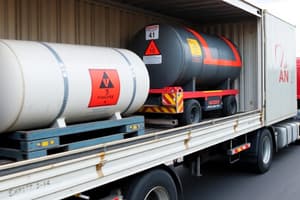Podcast
Questions and Answers
What are the objectives of transporting dangerous goods?
What are the objectives of transporting dangerous goods?
- Identify what constitutes a dangerous good. 2. List the different classes of dangerous goods. 3. Understand the labels used for different classes of dangerous goods. 4. Understand various limitations placed on dangerous goods. 5. Identify what is a NOTOC. 6. Identify information given in the emergency response guide.
What are dangerous goods?
What are dangerous goods?
Dangerous goods are articles or substances that are capable of posing significant risk to health, safety, property, and the environment when transported by air.
Where will you find recommendations for transporting dangerous goods?
Where will you find recommendations for transporting dangerous goods?
ICAO's 'Technical Instructions for the Safe Transport of Dangerous Goods by Air'
What do airlines use to comply with the ICAO document?
What do airlines use to comply with the ICAO document?
What section are dangerous goods classified in?
What section are dangerous goods classified in?
Where would you find limitations for the carriage of dangerous goods?
Where would you find limitations for the carriage of dangerous goods?
Where can passengers find information about dangerous goods?
Where can passengers find information about dangerous goods?
How many groups of dangerous goods are there?
How many groups of dangerous goods are there?
What are the groups of dangerous goods?
What are the groups of dangerous goods?
Where is each class identified?
Where is each class identified?
Can classes of dangerous goods be subdivided?
Can classes of dangerous goods be subdivided?
How many subclasses does Class 1 (Explosives) have?
How many subclasses does Class 1 (Explosives) have?
How many subclasses does Class 2 (Gases) have?
How many subclasses does Class 2 (Gases) have?
What defines a Class 3 (Flammable Liquid)?
What defines a Class 3 (Flammable Liquid)?
How many sub-classes does Class 4 (Flammable Solids) have?
How many sub-classes does Class 4 (Flammable Solids) have?
How many sub-classes does Class 5 (Oxidising Substances and Organic Peroxide) have?
How many sub-classes does Class 5 (Oxidising Substances and Organic Peroxide) have?
How many sub-classes does Class 6 (Toxic and Infectious Substances) have?
How many sub-classes does Class 6 (Toxic and Infectious Substances) have?
How many sub-classes does Class 7 (Radioactive Material) have?
How many sub-classes does Class 7 (Radioactive Material) have?
How many 'categories' do radioactive materials have?
How many 'categories' do radioactive materials have?
What are Class 8 corrosives?
What are Class 8 corrosives?
What are Class 9 dangerous goods?
What are Class 9 dangerous goods?
What might be an undeclared dangerous good?
What might be an undeclared dangerous good?
What are labels classified under?
What are labels classified under?
Are labeled goods allowed to be carried by crew or passengers?
Are labeled goods allowed to be carried by crew or passengers?
What sort of handling labels are there?
What sort of handling labels are there?
Flashcards
Dangerous Goods
Dangerous Goods
Substances that pose risks to health, safety, property, or the environment during air transport.
IATA's Dangerous Goods Regulations
IATA's Dangerous Goods Regulations
A document that airlines adhere to for compliance with ICAO's recommendations for safe transport of dangerous goods.
Classes of Dangerous Goods
Classes of Dangerous Goods
Includes Explosives, Gases, Flammable Liquids, and Toxic Materials.
Dangerous Goods Labels
Dangerous Goods Labels
Signup and view all the flashcards
Class 3: Flammable Liquids
Class 3: Flammable Liquids
Signup and view all the flashcards
Class 4: Flammable Solids
Class 4: Flammable Solids
Signup and view all the flashcards
Class 5: Oxidizing Substances
Class 5: Oxidizing Substances
Signup and view all the flashcards
Class 6: Toxic Materials
Class 6: Toxic Materials
Signup and view all the flashcards
Class 7: Radioactive Material
Class 7: Radioactive Material
Signup and view all the flashcards
Class 8: Corrosives
Class 8: Corrosives
Signup and view all the flashcards
Class 9: Miscellaneous
Class 9: Miscellaneous
Signup and view all the flashcards
Undeclared dangerous goods
Undeclared dangerous goods
Signup and view all the flashcards
Handling Labels
Handling Labels
Signup and view all the flashcards
Limitations on Dangerous Goods
Limitations on Dangerous Goods
Signup and view all the flashcards
Study Notes
Objectives of Dangerous Goods Regulations
- Identify what constitutes dangerous goods.
- List the different classes of dangerous goods.
- Understand the labeling system for various classes.
- Recognize limitations placed on the transport of dangerous goods.
- Learn about the Notice to Captain (NOTOC).
- Access emergency response guide information.
Definition of Dangerous Goods
- Dangerous goods are substances posing significant risks to health, safety, property, and the environment during air transport.
Transporting Recommendations
- Recommendations for transporting dangerous goods are found in ICAO's "Technical Instructions for the Safe Transport of Dangerous Goods by Air."
Compliance Document for Airlines
- Airlines follow IATA's "Dangerous Goods Regulations" to meet ICAO's recommendations.
Classification of Dangerous Goods
- Dangerous goods are classified in Section 3.
Limitations for Carriage
- Information about limitations for dangerous goods is found in the Dangerous Goods Regulations.
Information Accessibility for Passengers
- Passengers can find information about dangerous goods through their tickets and notices at check-in counters.
Groups of Dangerous Goods
- There are nine groups of dangerous goods:
- Class 1: Explosives
- Class 2: Gases
- Class 3: Flammable Liquids
- Class 4: Flammable Solids
- Class 5: Oxidizing Substances
- Class 6: Toxic Materials
- Class 7: Radioactive Material
- Class 8: Corrosives
- Class 9: Miscellaneous
Identification of Classes
- Each class of dangerous goods is identified by a specific label.
Subdivision of Classes
- Classes can be subdivided; for instance, Class 2 gases include Flammable, Non-Flammable Non-Toxic, and Toxic gases.
Subclasses of Explosives
- Class 1 (Explosives) contains six subclasses.
- Most explosives are banned in air transport, except Subclass 1.4 (Ammunition for sporting goods).
Subclasses of Gases
- Class 2 (Gases) is divided into three subclasses:
- Flammable Gases
- Non-Flammable Non-Toxic Gases
- Toxic Gases
Class 3 (Flammable Liquid) Definition
- Defined by a flash point of 60.5 degrees Celsius (141°F) or below.
Subclasses of Flammable Solids
- Class 4 (Flammable Solids) consists of three subclasses:
- Flammable Solid
- Materials liable to spontaneous combustion
- Substances emitting flammable gases when wet
Subclasses of Oxidizing Substances
- Class 5 includes two subclasses:
- Oxidizing Substances
- Organic Peroxides that ignite easily
Subclasses of Toxic Substances
- Class 6 consists of two subclasses:
- Toxic Substances
- Infectious Substances
Class 7 (Radioactive Material) Subclass Information
- Class 7 has no subclasses but includes three categories based on transport index (TI):
- Category 1: White (TI=0)
- Category 2: Yellow (TI ≤ 1)
- Category 3: Yellow (TI ≤ 10)
Class 8 (Corrosives) Characteristics
- Class 8 includes liquids and solids that can destroy human tissue and other materials.
Class 9 (Miscellaneous) Definition
- Class 9 includes dangerous goods not categorized under other classes, such as dry ice.
Undeclared Dangerous Goods
- Examples of undeclared dangerous goods include camping and diving equipment, household goods, and toolboxes.
Labelling and Markings
- Labels are categorized under:
- Hazard Labels
- Handling Labels
- Consumer Labels
Prohibition of Labelled Goods
- Labelled dangerous goods are not permitted to be transported by crew or passengers.
Handling Labels Types
- Various handling labels include:
- Package Orientation
- Magnetized Material
- Cargo Aircraft Only
- Cryogenic Liquid
- Keep Away From Heat
- Lithium Battery Label
- Radioactive Material - Excepted Package
Limitations on Dangerous Goods
- Limitations regarding dangerous goods are outlined in Dangerous Goods Regulations.
Studying That Suits You
Use AI to generate personalized quizzes and flashcards to suit your learning preferences.




